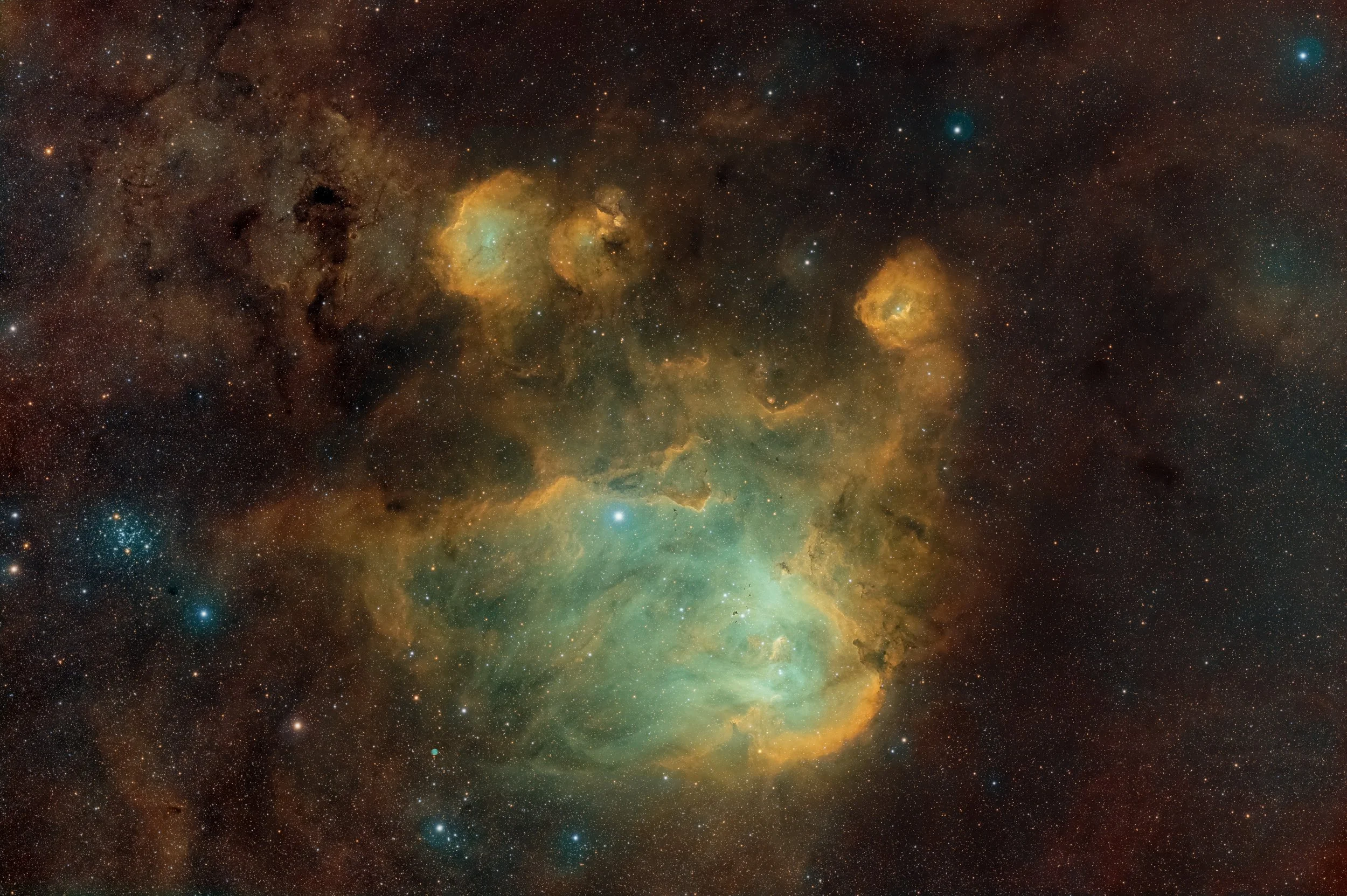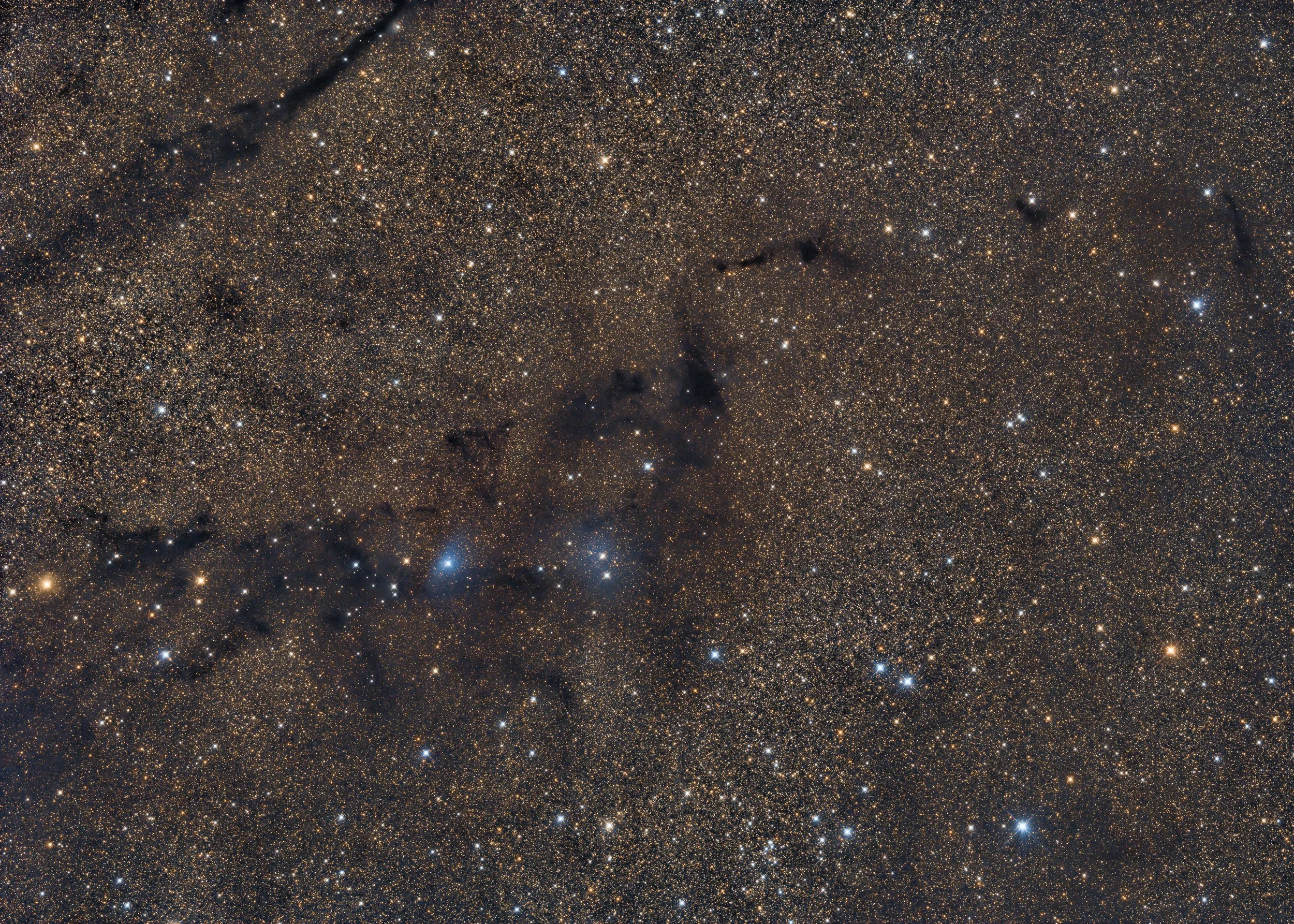
AAPOD2 Image Archives
The Running Cicken Nebula
The Running Chicken Nebula, also known as IC 2944, is a stunning emission nebula located in the constellation Centaurus, approximately 6,500 light-years away from Earth. This nebula is notable for its bright, glowing hydrogen gas, which is ionized by the intense ultraviolet radiation from nearby young, hot stars. The region is rich in star formation, with numerous young stars and protostars embedded within the nebula. One of the most striking features of IC 2944 is the presence of Bok globules—dense, dark clouds of gas and dust that are potential sites of future star formation.
IC 2944's nickname, the Running Chicken Nebula, comes from the shape of the nebula, which some observers liken to a running chicken. The complex structure of the nebula, with its bright emission regions and dark dust lanes, makes it a favorite target for both amateur and professional astronomers. Its location in the southern sky provides a unique and spectacular view for observers in the Southern Hemisphere.
LDN 769 / vdB 126 and NGC 6793 - Bejewelled Dust Monsters
LDN 769, vdB 126, and NGC 6793 are part of a fascinating region in the night sky. LDN 769, a dark nebula, obscures the light from the stars behind it, creating a striking silhouette against the backdrop of the Milky Way. Dark nebulae like LDN 769 are composed of dense clouds of gas and dust, which block visible light and are often sites of future star formation.
Adjacent to LDN 769, vdB 126 is a reflection nebula that glows with the light of nearby stars, scattering the light and giving it a distinctive blue hue. NGC 6793, an open star cluster, completes this celestial trio. These clusters contain young, hot stars that illuminate their surroundings, creating a vibrant contrast with the dark nebulae. Together, these objects showcase the dynamic and diverse nature of our galaxy's interstellar medium.
Sailing Stone
A geological phenomenon transported this rock and etched the tracks visible on the dried lake bed before you. For years, scientists were baffled by the force capable of moving it across the valley. Then, in 2014, two scientists captured a time-lapse of the rocks in motion. They discovered that the rocks drift when thin ice panels, formed underneath them on cold winter nights, begin to melt under windy conditions.
Numerous such stones and tracks are found in this part of Death Valley National Park, aptly named Racetrack Playa. They become even more spectacular under one of the darkest skies in the country, offering a unique blend of geological mystery and celestial beauty. The phenomenon remains a fascinating natural puzzle, captivating both geologists and visitors alike.
LDN204 and his dusty friends
This mosaic of LDN 204, composed of three tiles, captures the intricate beauty of the sky background, bringing together all the Hα emissions and dust in the field. The detailed observation offers a unique view of the complex interplay between hydrogen-alpha regions and interstellar dust.
Each tile in the mosaic reveals the rich structure of LDN 204, highlighting the delicate filaments and wisps of cosmic dust. The high-resolution images provide valuable data for astronomers, allowing for an enhanced understanding of the field's complex structure and contributing to our knowledge of the interstellar medium. This comprehensive approach not only showcases the nebula but also enriches our appreciation of the cosmic environment it inhabits.
The Golden Crescent and the Soap Bubble.
This image was acquired from my backyard in Victoria Texas. Featuring the famous Crescent Nebula, the well known target in Cygnus, but processed in Dynamic Narrowband Combination, to bring out the intricate Ha filaments in this shiny golden color. There are many other stories in this field of view, as the Soap Bubble makes an appearance at the top of the frame. To the far left of the frame, Abell 69 makes an appearance at an apparent size of only 22".
2-hour video of asteroid 2024MK
Asteroid 2024MK, a near-Earth object, recently made a close approach to our planet, providing a unique opportunity for observation and study. This 2-hour video captures the asteroid's movement against the backdrop of distant stars, highlighting its rapid transit across the sky.
Recorded using a series of time-lapse exposures, the video reveals the asteroid's apparent motion due to its proximity to Earth. The detailed observation period allows for precise tracking of its trajectory, helping astronomers refine their understanding of its orbit and physical characteristics. Such data are crucial for assessing potential future risks and understanding the composition and behavior of near-Earth objects. This video serves as a valuable tool for both professional astronomers and enthusiasts alike, offering a rare glimpse of a celestial visitor from our solar system's past.
NGC 6723, 6726, 6727, 6729 and friends
In the rich star fields near the border of the constellations Sagittarius and Corona Australis lies a fascinating collection of celestial objects. NGC 6723 is a bright globular cluster situated about 28,000 light-years from Earth. It is characterized by its dense core and myriad of ancient stars, some of the oldest in our galaxy, shining with a combined brightness that makes it visible even with small telescopes.
Adjacent to this ancient cluster is the intriguing reflection nebula complex of NGC 6726, NGC 6727, and NGC 6729. These nebulae are illuminated by the light from young, hot stars embedded within them, creating a striking contrast against the dark interstellar dust. NGC 6729, in particular, is associated with the variable star R Coronae Australis and displays dynamic changes in brightness and structure. This region is a stellar nursery, where new stars are being born, and their intense radiation shapes and sculpts the surrounding gas and dust into beautiful and complex structures. Together, these objects present a stunning tableau of stellar evolution, from the birth of new stars to the ancient glow of globular clusters.
North America and a Butterfly
### North America Nebula and Butterfly Nebula
NGC 7000, also known as the North America Nebula, is a vast emission nebula situated right beside the bright blue star Deneb in the constellation Cygnus. This nebula gets its name due to its resemblance to the North American continent when viewed through telescopes or in astrophotographs. The nebula spans about 50 light-years and is located approximately 1,600 light-years from Earth. It is part of the same molecular cloud as the Pelican Nebula and is one of the most well-known and photographed nebulae in the night sky due to its distinctive shape and vibrant colors.
The Butterfly Nebula, or IC 1396, lies close by in the same rich star field of Cygnus. This image, taken at the Barskoon Valley, situated between tall mountains in both the east and west, showcases both these stunning nebulae against the backdrop of the Milky Way. IC 1396 is a large, bright emission nebula that contains an open cluster of stars and several dark nebulae, including the prominent Elephant's Trunk Nebula. The region is an active site of star formation, where intense ultraviolet radiation from young, massive stars ionizes the surrounding hydrogen gas, causing it to glow and reveal the intricate structure of the nebula.
High resolution Cat’s Eye planetary nebula
NGC 6543, commonly known as the Cat’s Eye Nebula, is one of the most structurally complex nebulae known. Located about 3,300 light-years from Earth in the constellation Draco, this planetary nebula showcases a stunning array of intricate features when observed in high resolution. Its central region, a roughly 1,000-year-old planetary nebula, displays a bright, elliptical core surrounded by concentric rings, jets, and intricate filaments of gas.
The Cat’s Eye Nebula is a prime example of the end stages of stellar evolution for medium-mass stars. The nebula’s unique structure is believed to result from the interactions between the fast winds from the central star and the slower-moving material ejected in earlier phases. High-resolution imaging, especially from the Hubble Space Telescope, has revealed the nebula’s complex geometry, helping astronomers understand the mechanisms driving the formation of such elaborate shapes in planetary nebulae.











